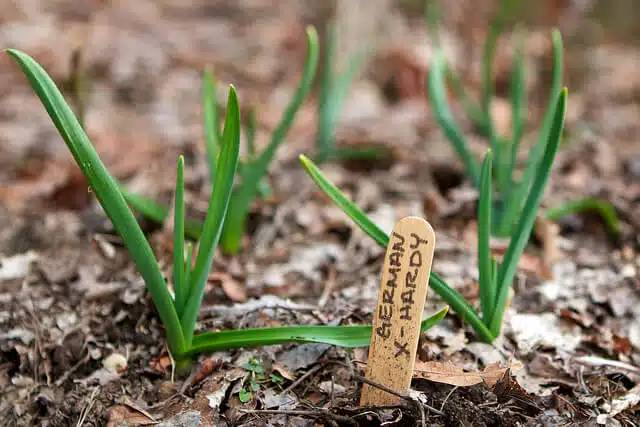Garlic is an easy plant to grow in pots. It’s started from cloves, not seed (you can see an interesting account of some of the hurdles involved in growing garlic from true seed in the further reading section). These are planted either in autumn or early spring.
Alongside its obvious culinary use, it also offers some pest-deterrence and is a good companion plant. That said, it is by no means completely immune, being a little susceptible to rust and white rot…though growing in pots will go some way in offering a natural solution.
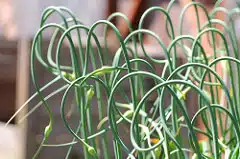
There are several varieties to choose from, which will be grouped as either soft neck or hard neck.
Hardnecks, which are usually tastier but don’t store for as long as their softneck compadres, are distinguished by their upright central stem, which will develop into a flower stalk, or scape. This should be removed from the plant when it appears and can be eaten. Softnecks do not produce a central stem, have bigger bulbs, and will store for much longer.
Planting is best done before Christmas, towards the end of autumn. That said, if you are late, cloves can go in until around April. One final point: don’t confuse a bulb with a clove: a bulb, which is what you buy in a supermarket, is a collection of cloves.
So, how to grow garlic in pots…
Summary
| Germination/sprouting time: | 10 – 14 days when weather is warm enough. |
| Time from planting to harvest: | 8 – 10 months for autumn-planted, 5 – 6 months for spring-planted. |
| Size of pot: | Medium (min. of 8 inches depth). |
| Difficulty of growing in pots? | Easy. |
Sowing and Harvesting Calendar
- Sow: October to April (late-year sowings will overwinter)
- Harvest: June to September
Sowing and Planting
- In theory you can plant at any time between October and April. Ideally you want to start them around November. which will allow for a little root growth before the very coldest weather sets in. Garlic ideally requires a cold spell of 10 – 30 days with a nighttime temperature of below 10°C/50°F. These lower temperatures trigger what is called bulb initiation.
- When planting in autumn try and position the pot somewhere it won’t get waterlogged over winter. Garlic bulbs hate being soaked for long periods of time and the cloves are more likely to rot. If standing water freezes in the pot, they can also be similarly damaged.
- When blending your potting mix, in order to aid drainage, incorporate a few big handfuls of perlite or composted bark. Mix in a slow-release fertilizer or remember to liquid feed after the typical six week period.
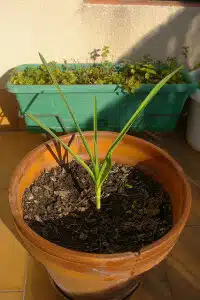
- If you want to pop your cloves into their pots in January or February, it’s even more important make sure that your mix is very well-draining. They’ll get their cold period and be ready to start off as soon as temperatures allow (if it’s very cold they’ll stay dormant in the ground until then). Some additional protection from rain if it’s very wet won’t go amiss – so put the pots in the greenhouse or tie some clear plastic over the pot.
- Spring-planted bulbs (March onwards) will benefit from being placed in the fridge for a week or so. Spring “sown” cloves, if not cold treated, can still grow but the chances of meagre bulbs is much higher.
- Plant cloves about 1 in./2.5 cm deep allowing around 2/3 in. between them and the sides of the container. Because the plants have quite an upright habit they can be grown closely(ish) together.
- Avoid supermarket bulbs. They will usually be softneck varieties and often have some growth-inhibiting chemical added to the surface.
- Because of its pest-deterrent qualities, consider interspersing it amongst your other plants, particularly those that are susceptible to aphids.
Growing Tips
- If incorporating an organic slow release (such as blood, fish and bone) side dress with a little nitrogen-rich feed when plants are around six inches high.
- If the garlic produces flowers before you’re ready to harvest just snip them off.
- Water well during dry spells, but not after the foliage has started to yellow.
Harvesting
- Between June and August, when the foliage begins to yellow and wither, they are ready for picking. As a general rule you want to have about five or six stems that are still green.
- Before storing allow the cloves to dry out fully in a well-lit spot (ideally sunlit) such as on a windowsill. Hang them in storage.
Good Garlic Varieties for Pots
- Purple Wight (soft-neck) is a popular, fast-growing variety. It doesn’t store for long but tastes wonderful and has a lovely purple-streaked skin. It is a fast-grower and will usually be ready to harvest a little earlier than other varieties.
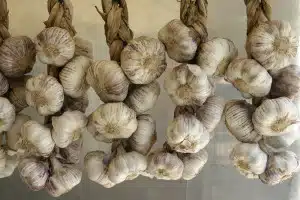
- Arno (soft-neck) produces smaller bulbs with lots of tightly packed cloves and for this reason is particularly well-suited to containers.
- Solent Wight (soft-neck) is small-growing (great for pots) and particularly well-suited to British weather (it hails from the Isle of Wight).
- Germidour (soft-neck) is the traditional type of garlic you are most likely to find on a supermarket shelf. Worth growing if you’re after something reliable
- Lautrec Wight (hard-neck) is renowned for its flavour and is compact enough (about 60cm in height) to be considered for pots. It’s regarded as one of the best varieties of garlic in France.
Pests and Problems
- Birds can pull up the cloves and eat the early foliage growth. You can avoid this by covering your pots with some mesh or horticultural fleece. Try a scarecrow if you’re in the mood…tough I’ve been told results can vary.
- White Rot (a fungus) is signalled by premature yellowing and wilting of foliage. The bulb will also be covered around the base with a whit, black-dappled fuzz. There is no cure (the crop will likely already have been damaged) but it’s not something to worry about too much as a container grower. It must initially be present in the potting soil so if you do have a case of it, just sterilize your pots.
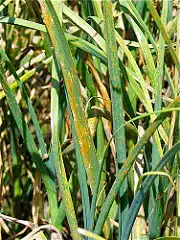
- Rust causes bright yellow spots on leaves and can be worse during prolonged periods of wet weather, A small outbreak shouldn’t damage the plant too much. You can remove badly affected leaves
Interesting Trivia
- Garlic reproduces vegetatively (asexually) rather than sexually (through seed). It is incredibly difficult to grow garlic from seed.
- It’s one of the oldest cultivated crops in the world (it was eaten over 10,000 years ago) and most is grown in China.
- Alongside other pests, it’ll also keep demons, werewolves and vampires away from your container plot.
